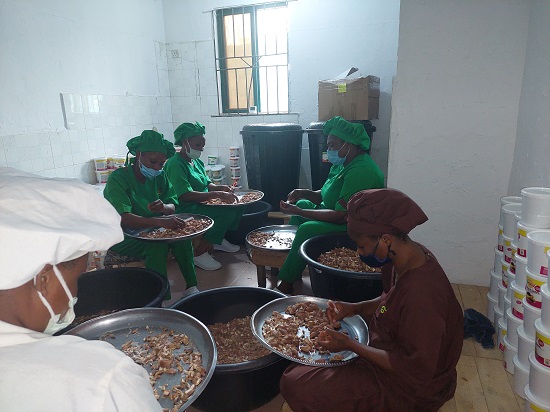On a sunny afternoon, two-year-old Dorcas Okon was asleep on her mother’s back; unperturbed by her environment, she intermittently cooed, prompting Esther Okon, her 28-year-old mother, to change position on the plastic chair.
Except one is told, it is hard to tell that Dorcas had once been severely malnourished. When she turned six months, Dorcas gradually developed selective eating behaviour. As months went by, Esther’s fear mounted as Dorcas grew slimmer. Seeing her daughter’s condition, the young mother was willing to sacrifice all to ensure her child received treatment.
She would shed tears during daily prayer sessions. Since Esther’s husband lost his job, and she wasn’t also employed, they were unable to feed Dorcas with nutritious food. So, she could only turn to providence for a quick fix.
When the situation became worse, she visited the Ifako Primary Healthcare Centre (PHC) in Lagos. The PHC, through an existing partnership, then referred Dorcas to the Lagos Food Bank (LFB), a hunger-relief not-for-profit company, where in-house nutritionists diagnosed her with severe acute malnutrition (SAM).
Advertisement
“That was December 2021, and Dorcas was 15 months old, but she could not walk yet,” Esther said at the LFB warehouse, in Lagos, where she had come to receive another round of food products.
“They (LFB) gave me some nutritious food products. They also guided me on how to prepare it. Within three months of preparing the meals, my baby began to gain weight. In no time, she started walking.
“After that time, the situation got a lot better. I also got a menial job in March. But my husband is not working yet.”
Advertisement

Through LFB’s nutritious meal plan intervention for vulnerable mothers and children (NUMEPLAN), an orientation and food provision initiative, Dorcas, who weighed five kilogrammes when she was enrolled in the programme, gained additional 3.5 kilogrammes (kg) in about three months.
“IT’S A MIRACLE”
Like Dorcas, 18-month-old Testimony Ikechukwu was referred to LFB from a primary healthcare centre in the Agbado area of the state.
At nine months, he could not crawl. Even though he was breastfed constantly, getting Testimony to accept other food items or liquid was a herculean task for the mother. Nkechi Ikechukwu, his 34-year-old mother, said how things turned around for his son was nothing short of a miracle.
Advertisement
“It got really bad because he was a fussy eater and I was not giving him food with adequate nutrients that he needed either,” she said.
“He was underweight and sick at that time. That was why they (the PHC) referred him to LFB. They assured me that some officials would attend to us.’’
Nkechi said yielding to the orientation she received that “a baby is supposed to eat every three hours, not anytime you wish” helped Testimony recover rapidly. She added that the food supplies from the NGO also helped him gain weight.
In about four months, Testimony gained 2.5 kg following the NUMEPLAN intervention while her mother continues to receive food supplies from LFB.
Advertisement
Moinot Kareem, 32, was also present at the LFB warehouse. Fareehan, her daughter, was enrolled in the programme in June and has gained a considerable amount of weight.
She said Fareehan “suffered from oka ori” — the Yoruba word for the soft spots in a baby’s skull called fontanels — since she was born. Moinot said even though she did exclusive breastfeeding for her baby for six months, “the oka still affected her”.
Advertisement

“When she was born, I complained at the health centre about her weight. Then, the doctor said she had oka; we used the medicine that was prescribed,” she said.
“I was directed to the food bank. I have been coming to the warehouse consistently, and they have been providing me with food. As time passed, I noticed that my baby was fast changing as I fed her more nutritious meals. I realised that maybe I had been getting it wrong all along.”
Advertisement
According to NiMed Health, a research-based health information site, although the presence of the soft spot in a newborn is not an illness and is normal, it can be made more obvious by other factors including malnutrition.
FEEDING MOTHERS, CHILDREN IN UNDERSERVED COMMUNITIES
Advertisement
According to LFB, the first privately-owned food bank in Nigeria, over 1,500 beneficiaries have been enrolled in the NUMEPLAN programme since 2019.
The beneficiaries include under-five children, pregnant teenage girls and women and lactating mothers.
Grace Anamelechi, programme support officer at LFB, said the organisation targets hard-to-reach communities and low-income earners.
“When the PHCs refer the mothers to us, we check their background information — what they do, their operations and if possible, their family income — to determine whether they are actually in need of the interventions that we provide,” Grace said.
“We put them on a one-year plan. We have the four to six months of constant monitoring, and once we are sure that they are actually getting to a state of optimal nutrition, we invite the mothers every other month.”
The programme support officer noted that if a child is more likely to relapse after a certain point, the in-house nutritionists usually invite mothers for follow-up every month.
Grace said this depends on the distance of the beneficiaries’ residence to the NGO. On some occasions, she said the nutritionists do not require the physical presence of the mothers; hence, they call them over the phone to see if there are issues that need to be addressed.
Entrusted with the tremendous task of providing food and guidance to these mothers, she said corporate donations support the course.
GRIM STATISTICS
While the likes of Dorcas, Testimony, and Fareehan were fortunate to be reached with treatment, there are 17 million malnourished children — stunted and/or wasted — in the country, according to the United Nations Children’s Fund (UNICEF).
“Wasting” is a term used for children who are too thin for their height, while “stunting” is when a child has a short height for their age. Principally, malnutrition occurs in children who are either undernourished or overnourished.
In Nigeria, 37 per cent of children are stunted, 7 per cent are wasted and 22 per cent are underweight (thin for their age), according to the Nigeria demographic and health survey (NDHS) 2018 report.
Each year, about 1 million Nigerian children die before their fifth birthday, and malnutrition
contributes to nearly half of these deaths, according to the 2018 national nutrition and health survey (NNHS).
In November 2022, the United Nations Children’s Fund (UNICEF) said 100 children under the age of five die of malnutrition in Nigeria every hour.
Nemat Hajeebhoy, UNICEF’s chief nutrition officer, speaking at a meeting, said, “If a child is malnourished, they are 12 times more likely to die.
“We know that today, without urgent action, there would have been close to 15 million children who will suffer from what we call wasting this year and next year.”
COMPLEMENTARY FEEDING IMPORTANT
Speaking on malnutrition detection, Gbemisola Boyede, a consultant paediatrician, said malnourished children often do not gain weight as expected for their age.
Boyede, who is also the founder of Ask The Paediatricians Foundation, added that if malnutrition is persistent, then the child’s height will also be affected, leading to stunting. She said there are many other signs of malnutrition, including skin changes, a tendency to have recurrent infections and mouth sores.
“The way to prevent malnutrition is to ensure that children are fed properly. Parents have to first understand the principles of infant nutrition and ensure they follow it,” Bayode said.
For most mothers who spoke to TheCable, the challenges began at the toddlers’ dietary transition point – six months – when complementary foods were introduced.
Complementary feeding is the process of giving a child other liquid food in addition to breast milk.
According to the World Health Organisation (WHO), after exclusively breastfeeding an infant for six months, if complementary food is not introduced or if they are given inappropriately, an infant’s growth may falter.
Ifeyinwa Omesiete, a paediatric nutritionist, said some local food can provide the needed nutritional values for infants.
“There is also a lot of misinformation that Nigerian local food is not good for children. We need to change the mindset of that conversation and state that Nigerian foods are actually healthy. They are full of vitamins and minerals,” she said.
Ifeyinwa said there are also local brands that provide baby food for Nigerian children.
“In fact, if you look at larger food production companies, a lot of them have begun to diversify their efforts by providing similar products to what we import here in Nigeria,” Ifeyinwa noted.
Findings by TheCable showed that these indigenous firms have developed tailor-made food products for African children using locally-sourced products like millet, wheat, and potatoes.
The baby food market has a promising future in Nigeria, with a higher adoption rate witnessed from 2018 to 2023,” according to Ken Research.
It said the baby food is expected to grow remarkably, valuing over N200 billion by 2023.
To get a sense of the Nigerian baby food companies — not multinationals — and how they are helping to bridge Nigeria’s malnutrition gap, TheCable spoke to two companies: Baby Grubz and Colourful Giggles.
FOR FIRST INDIGENOUS BABY FOOD COMPANY, IT’S ALL ABOUT THE CHILDREN
Baby Grubz, an indigenous baby food company that prides itself as the first in Nigeria, was established in 2013. The company, which also donates its products to LFB, is a Lagos-based social enterprise.
Seun Sangoleye, chief executive officer of Baby Grubz, had also struggled with getting it right during her child’s complementary feeding stage. In her quest to gain insight into how to feed her son, she saw a gap that needed to be filled. That gap, she said, inspired her to establish the company.
In 2012, when Seun was about to resume work after her 3-month maternity leave, she introduced other food items to her son. He rejected different formulas and refused expressed milk as well. She turned to family and friends and got conflicting responses about the proper feeding technique.
“So, I went online. I could not find information that was in the Nigerian context. There was nothing. But I saw a lot of things from Baby Centre, Canada, UK, and the NHS. But anyways, some of the things that I found then were eye-opening,” she said.

Her company’s evolution, she said, started from giving nutritional advice to mothers via a blog site, to preparing meals for infants and then foraying into the production of dried baby foods. For Seun, providing affordable meals to children is the focus of her business.
“Because it was all about the children, I normally would have started out as an NGO. However, at that time, I was not educated about the NGO space,” she said.
With solely women distributors, the company not only sells its products but also empowers these women to provide peer-to-peer mentoring in their respective communities.
“With this, mothers have representatives in their community; and so, it is helping with social development and nutrition knowledge,” she said.
“Also, the fact that you have another person who understands what you are going through in your neighbourhood and who you can talk to about child feeding issues is a plus.”
FOR COLOURFUL GIGGLES, IT’S ABOUT PRESERVING THE FUTURE OF CHILDREN
On its part, Colourful Giggles does business with the aim of improving maternal and child health.
Adepeju Jaiyeoba, founder of the company, who had also established Brown Button Foundation and Mother’s Delivery Kit, said democratising access to healthcare products as well as nutritional products is at the core of her business.
“The whole thing that we are trying to do is reduce maternal and child mortality,” she said.
“So, in 2018, when we reached about a million mothers and their babies at Mother’s Delivery Kit, we realised that some healthy babies that we celebrated on that day would not live to see their fifth birthday. They were going to die of malnutrition, and that was what triggered me to begin to look at the nutrition industry.
“If you look at my trajectory – all the things I am involved in – I am focused on democratising access or things, whether it is health care systems, delivery kit products, or food. I believe that the location of a child at birth should not be a determinant in whether the child should be fed good food or not.
“The future of our country is actually in what the children eat when they are under three years old and that is another reason why we are focusing on nutrition.”
CHALLENGES ABOUND
For LFB, access to finance is still a hurdle that would need to be scaled.
“The major difficulty of an NGO is finance. It is a not-for-profit organisation, and so it is not like we are selling something to get profit back,” Grace said.
“So most times, it is usually difficult for us to get organisations that believe in what we are doing and want to support us.”
For Colorful Giggles, challenges include distribution, poor road network system and raw material sourcing. She also noted that managing the cost of production was another issue as passing the cost to customers means more money will be spent on children.
For Baby Grubz, Seun said insecurity in the northern region of the country has impacted negatively on her business.
“Although we still buy some things from the north, we are looking for alternatives. I don’t know about others, but for us, there is still a bit of struggle when it comes to supply chain which is a major strength for these sort of business,” she said.
Regardless of these challenges, these organisations are making a difference and helping to preserve the future generation.
Add a comment






